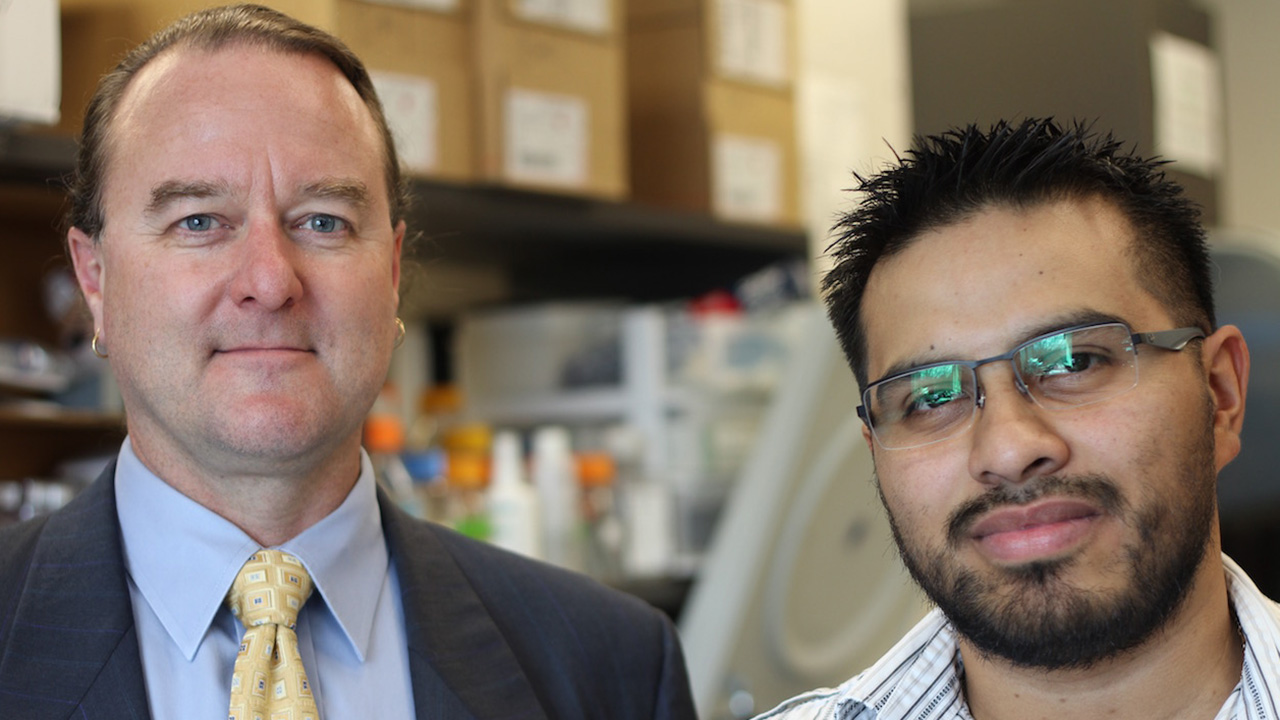Researchers find viral molecule that restrains immune cells
Scientists at Sunnybrook Research Institute (SRI) have discovered a viral molecule that inhibits natural killer (NK) cells, a type of white blood cell that plays a key role in fighting cancer and infection. The finding sheds light on important aspects of the immune system and how viruses have evolved to evade recognition.
Oscar Aguilar, a PhD student at SRI from the University of Toronto, and his supervisor, SRI senior scientist Dr. James Carlyle, have identified the first protein known to bind to the NK1.1 receptor, which belongs to a family of NK cell receptors called the NKR-P1 proteins. The receptor was first discovered 40 years ago as the prototypical NK cell marker. Since then, researchers have tried to find any molecule that interacts with NK1.1 and have come up empty—until now.
“This is a little bit of a holy grail situation where it’s the first NK cell receptor ever identified and the ligands have remained a mystery for four decades,” says Carlyle, an associate professor of immunology at U of T.
Aguilar and Carlyle are lead authors of a study showing that m12, a viral protein identified in mouse models that study beta-herpesviruses, binds to NK1.1 and other receptors in the NKR-P1 family.
The paper was published March 23, 2017 in Cell.
The job of NK cells is to patrol the body and protect it from disease. They spring into action by two mechanisms. One occurs when stimulatory receptors on NK cells bind to stimulatory molecules on tumour cells or infected cells. This interaction tells the NK cell to release a lethal protein that instructs diseased cells to die. The other is through “missing-self” recognition: NK cells sense a loss of self-recognition proteins on their surface that is caused by pathogens. The loss of these proteins releases the brakes on normally restrained NK cells, thereby freeing them to attack.
The family of NK cell receptors the researchers studied has three stimulatory receptors that activate NK cells (including NK1.1) and two inhibitory receptors, which, when they bind to inhibitory “self” molecules on target cells, shut down NK cells.
When the researchers studied cells infected with a mouse beta-herpesvirus (a mouse form of cytomegalovirus), they observed decreases in a self-recognition protein called Clr-b—a function that is akin to triggering an alarm. Interestingly, they also saw a strong signal from one of the inhibitory receptors, NKR-P1B, which rapidly shut the alarm off.
“So, virus infects cell, cell removes the host molecule so that NK cells can activate and kill the virally infected cell. But the virus has encoded a molecule that acts as a decoy that interacts with the same receptors, so the NK cell does not kill the infected cell. The m12 molecule serves as protection from the NK cell,” says Aguilar, who is the study’s co-first author.
By using different strains of the virus and analyzing interactions between molecules, Aguilar was able to identify the m12 protein as the decoy molecule that was blocking NK cells by binding to the NKR-P1B inhibitory receptor.
What also surprised the researchers, who worked with colleagues in North America, Europe and Australia on the study, is that the m12 protein also weakly interacted with two stimulatory receptors, called NKR-P1A and NKR-P1C (NK1.1). Taken together, the results suggest an unfolding struggle, one where each organism is adapting to other’s devices.
“The weak interaction really demonstrates the host and pathogen evolution. The reason why the inhibitory interaction is the stronger response is because the virus is evolving to make sure it inhibits NK cells, whereas the host is trying to evolve mechanisms that also recognize this decoy—but I think the virus is winning, at least with respect to this [study],” says Aguilar.
The next step is to study cytomegalovirus and the NKR-P1A receptor in humans to see if there is a corresponding viral decoy protein. About 70% of adults are infected with this virus, but most show no symptoms because a healthy immune system prevents the virus from causing illness. In people whose immune systems are compromised, however, like those with AIDS or who are undergoing chemotherapy, cytomegalovirus can cause serious damage, for example, to the liver, lung, eyes and nervous system.
Funding for this study was provided by the Burroughs Wellcome Fund, Canadian Institutes of Health Research, Natural Sciences and Engineering Research Council of Canada, and the Ontario Ministry of Research, Innovation and Science, with support from international agencies.
Read the media release on this study from the University of Toronto.
Read the publication in Cell.






